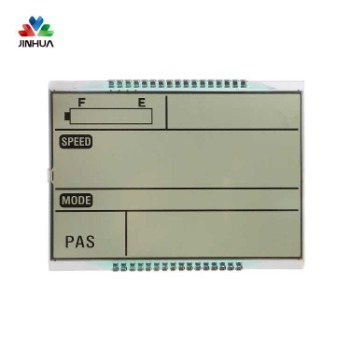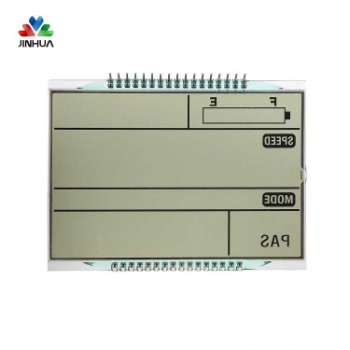Modo de visualización LCD
En lo que respecta a los modos de visualización, existen dos tipos de LCD, LCD positivo y LCD negativo.
Modo de visualización positiva
La imagen en el monitor LCD es transparente cuando el píxel está en "APAGADO". Cuando un píxel está "ON", es opaco. Este modo de funcionamiento se utiliza principalmente en lugares con mucha luz ambiental. Y ayudará con el contraste del monitor, especialmente para monitores que utilizan polarizadores traseros reflectantes. Por ejemplo, caracteres alfanuméricos sobre un fondo más grande. Los segmentos o puntos del personaje absorberán la luz (apareciendo oscuros), mientras que el fondo reflejará la luz para realzar el personaje. A continuación se muestran algunas combinaciones típicas de Modo de operación y Modo de visualización y las imágenes resultantes:
TN: caracteres negros sobre fondo gris
STN-Verde: Caracteres morados oscuros/negros sobre un fondo verde.
STN-Silver: caracteres azul oscuro/negro, fondo plateado
FSTN: caracteres negros sobre fondo blanco/gris
Modo de visualización negativo
Una imagen negativa en un pantalla LCD es opaco cuando un píxel está "APAGADO". Cuando un píxel está "ON", es transparente. En este modo, se minimiza la parte de la pantalla que refleja la luz y proporciona definición de caracteres. Por lo tanto, este modo se utiliza normalmente cuando hay luz de fondo y las condiciones de iluminación ambiental son tenues. Con luz de fondo, las partes transparentes de la pantalla "brillarán". La luz de fondo puede atravesar el área cuando el píxel está encendido y la luz ambiental intensa puede atenuar la luz de fondo. A continuación se muestran algunas combinaciones típicas de Modo de operación y Modo de visualización y las imágenes resultantes (suponiendo que aparezca una luz de fondo con el color especificado):
TN: Caracteres brillantes de color verde y amarillo sobre un fondo gris claro (luz de fondo de color amarillo y verde)
STN ("Blue Negative"): caracteres brillantes de color amarillo verdoso sobre un fondo azul claro (luz de fondo de color amarillo verdoso)
FSTN: caracteres blancos iluminados sobre fondo negro (luz de fondo blanca)
polarizador LCD
Cada LCD tiene 2 polarizadores, frontal y posterior. Están colocados en la parte frontal de la superficie de visualización de la pantalla y en la parte posterior de la pantalla para determinar cómo se dirige la luz hacia la pantalla. pantalla LCD. El polarizador frontal siempre es transmisivo y el usuario no puede cambiarlo, pero hay tres opciones para el polarizador trasero.
Polarizador transmisivo
Los polarizadores traseros transmisivos se utilizan en aplicaciones en entornos oscuros que requieren retroiluminación y pueden maximizar el brillo de la retroiluminación. La mayoría (pero no todas) las pantallas transmisivas son imágenes negativas y, a veces, agregamos filtros de color a ciertas áreas de la pantalla para resaltar diferentes anunciadores. Otro ejemplo de una pantalla polarizadora transmisiva es una ventana transparente donde puedes ver segmentos que se superponen a tu línea de visión a través de la ventana de visualización (como en una película de ciencia ficción).
Polarizador reflectante
Las pantallas reflectantes tienen un polarizador trasero transparente e incluyen un reflector difuso. Se utilizan en aplicaciones sin retroiluminación debido a una potencia de retroiluminación insuficiente o a una intensidad de luz ambiental insuficiente. Son especialmente adecuados para su uso en dispositivos que funcionan con pilas y que siempre proporcionan un nivel suficiente de luz exterior.
Tipo semitransmisivo
Las pantallas transflectivas tienen un polarizador posterior que incluye un material translúcido. Y refleja parte de la luz ambiental y también transmite la luz de fondo. Por lo tanto, cuando se enciende la luz de fondo, la imagen se puede ver con luz ambiental alta o baja.






 English
English Deutsch
Deutsch русский
русский español
español العربية
العربية



 IPv6 RED SOPORTADA
IPv6 RED SOPORTADA
